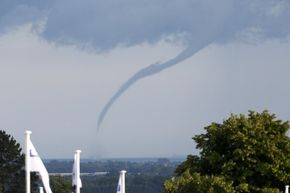Marksville, Louisiana, 1947: Fish are reported falling from the sky. Odzaci, Serbia, 2005: Thousands of frogs rain upon the city. Lajamanu, Australia, 2010: Hundreds of spangled perch drop from the sky down onto the small town. Los Angeles, 2013: Great white sharks pelt the metropolis from the sky, massacring everyone in sight.
OK, maybe that last one wasn't true. But with all the documented instances of animals getting sucked into tornadoes and plummeting en masse back to the earth, maybe it could be. At least that's what the 2013 film "Sharknado" would have you believe.
Advertisement
In the movie (and its obligatory sequels, "Sharknado 2" and "Sharknado 3"), a freak cyclone hits the oceanfront, and sharks are sucked into the whirling winds. As the storm moves over the city (Los Angeles in the first movie, New York in the second and Washington, D.C., in the third), the sharks drop out of the sky and attempt to rip apart anything in their path. As if that weren't enough, sharks enter the streets as well with the massive flooding from the storm. The sharks attack the city dwellers from the land, air and sea, leaving them no escape from the bloodthirsty beasts.
While we know this B movie isn't actually real, could it be? Or at least some elements of it? Let's explore exactly what would have to happen to turn this campy thriller into a real-life nightmare.
Advertisement




